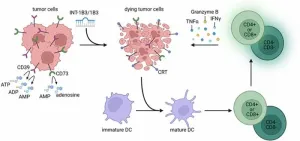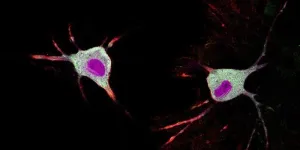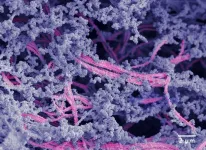(Press-News.org) In a new article for the journal Proceedings of the National Academy of Sciences, UC Santa Cruz researchers laid out the foundation for their highly-anticipated upcoming study of how lack of affordable housing in urban areas of California may be driving increased development in and near wildlands, leading to more severe climate change impacts.
Since the 1990s, California has led the nation in the growth of Wildland-Urban Interface (WUI) development, with more than one in three households in the state now located immediately next to or within natural areas. This proximity to wildlands puts WUI residents at higher-risk for climate-related natural disasters like fires, floods, and landslides. Extensive WUI development also makes wildfires more likely, while negatively impacting wildlife habitat and resulting in longer commutes, which increases greenhouse gas emissions.
Despite growing recognition of the serious hazards and massive scale of WUI development, the causes of this type of growth are still not well understood. UC Santa Cruz Sociology Professor Miriam Greenberg, lead author of the new article, believes that incorporating new perspectives and methods from the social sciences will help to change that.
“In the past, most approaches to studying the WUI have been from a natural systems perspective,” she said. “But our research aims to demonstrate that you can’t extricate these environmental and ecological dynamics from urban and housing dynamics—it’s all interconnected. So we’re really excited to be doing primary research that will help us understand, for the first time, the drivers, demographics, and related dynamics of WUI growth, taking the broader context of the housing crisis into consideration.”
Greenberg added that California has the unfortunate distinction of facing both the most extreme housing crisis in the United States and a rate and scale of WUI growth that is unequaled elsewhere in the country. That makes the state a particularly important laboratory for studying these issues and the potential relationships between them.
For the upcoming research, which is currently in progress, the team is using a mixed-methods approach that will include surveys and ethnographic interviews and will integrate census data with WUI mapping and ecology data. Another aspect of the study, which was not a focus of the recent article, will explore Indigenous land stewardship, habitat restoration, and prescribed burning in the context of WUI growth. The research will be conducted along California’s Central Coast, one of the most unaffordable housing markets in the U.S.
The project will involve a wide range of community partners and faculty and staff across UC Santa Cruz and San Jose State, including Associate Professor of Sociology Hillary Angelo and Environmental Studies Professor Chris Wilmers, who are coauthors of the current article alongside Greenberg and UCSC Sociology graduate student Elena Losada.
The paper shares three main predictions for trends that the research team thinks they will find in the WUI. First, they believe there has been a major shift in what motivates people to move to WUI areas. While people may have historically chosen to live in the WUI because of generational ties to an area or a desire to be closer to nature, the researchers believe that housing affordability has become a main driver of increased migration to the WUI since the 1990s, as a growing number of Californians have been priced out of urban areas due to the state’s worsening housing crisis.
The demographics of this may play out differently in different types of WUI areas, which themselves are shaped by a combination of political, economic, and environmental factors. For example, WUI “interface” development that sprawls out from urban areas to the edges of wild areas is likely to be filled primarily with middle-income commuters, the researchers suspect. Meanwhile, they expect that more remote development within wildland areas—called WUI “intermix” development—will have particularly stark inequality, featuring a combination of estates for the wealthy, modest older homes, and informal, off-the-grid living, including in trailers and vehicles.
The paper argues that the rise of affordability-driven migration has likely resulted in overall growth of inequality in the WUI, and this has exacerbated the impact of environmental disasters fueled by climate change. While all residents of these communities face the same risks, differences in wealth, time availability, and knowledge of the local landscapes mean that households have very different abilities to prepare for and recover from disasters, researchers believe. As a result, newer and lower-income residents who move to the WUI primarily for affordability reasons may end up suffering disproportionately when disaster strikes.
Overall, the paper’s authors anticipate that their findings will demonstrate the need to treat the affordable housing crisis as not only a major social issue but also a significant sustainability problem that must be addressed in order to protect communities from climate change.
Tackling that challenge will require integrating planning and policy for housing and climate change at the local, state, and federal levels, as well as routinely bringing the social sciences and natural sciences together for research on these issues, the paper says. Ultimately, the research team argues that affordable housing production and preservation and protection of tenants in urban areas are crucial actions that shape sustainability, both within cities and far beyond.
“We really need to expand the frontiers of how we think about urban sustainability, because it doesn't just end at city boundaries,” said the paper’s coauthor, Associate Professor of Sociology Hillary Angelo. “Without enough affordable urban housing, people are being pushed to riskier areas outside of cities, and that makes cities unjust while also having terrible social and environmental impacts elsewhere. Understanding these interconnections is key to true sustainability.”
END
An overlooked side-effect of the housing crisis may be putting Californians at increased risk from climate disasters
2024-08-05
ELSE PRESS RELEASES FROM THIS DATE:
INT-1B3 miR-193a-3p mimic boosts t cell immunity and induces tumor cell death
2024-08-05
BUFFALO, NY- August 5, 2024 – A new research paper was published in Oncotarget's Volume 15 on July 12, 2024, entitled, “INT-1B3, an LNP formulated miR-193a-3p mimic, promotes anti-tumor immunity by enhancing T cell mediated immune responses via modulation of the tumor microenvironment and induction of immunogenic cell death.”
In this study, researchers Chantal L. Duurland, Thijs de Gunst, Harm C. den Boer, Marion T.J. van den Bosch, Bryony J. Telford, Rogier M. Vos, Xiaolei Xie, Mingfa Zang, Fang Wang, Yingying Shao, Xiaoyu ...
Wayne State University professor receives NSF grant to study quantum tunneling
2024-08-05
DETROIT — A Wayne State University professor recently received a three-year, $626,467 grant from the National Science Foundation’s Division of Physics. The project, “Probing Nonadiabatic Strong Field Ionization with Phase-Resolved Attoclock,” will research a quantum mechanical process known as quantum tunneling.
Wen Li, Ph.D., professor of chemistry in Wayne State’s College of Liberal Arts and Sciences and his research team propose a new technique they have developed to study the process of quantum tunneling, a quantum mechanical phenomenon in which an object such as an electron or atom passes through ...
Adding metastasis-directed radiation therapy boosts progression-free survival in metastatic pancreatic cancer
2024-08-05
Researchers from The University of Texas MD Anderson Cancer Center demonstrated that adding metastasis-directed radiation therapy to standard-of-care chemotherapy improved progression-free survival (PFS) in patients with oligometastatic pancreatic cancer. Findings from the multicenter EXTEND trial, published today in the Journal of Clinical Oncology, were first presented at the 2024 American Society of Clinical Oncology (ASCO) Gastrointestinal Cancers Symposium.
At a median follow-up of 17.3 months, PFS was 10.3 months in patients who received metastasis-directed therapy (MDT) ...
New method tracks how psychedelics affect neurons in minutes
2024-08-05
Researchers at the University of California, Davis have developed a rapid, noninvasive tool to track the neurons and biomolecules activated in the brain by psychedelic drugs. The protein-based tool, which is called Ca2+-activated Split-TurboID, or CaST, is described in research published in Nature Methods.
There has been mounting interest in the value of psychedelic-inspired compounds as treatments for brain disorders including depression, post-traumatic stress disorder and substance use disorder. Psychedelic ...
Record number of drug overdoses in one year reported
2024-08-05
August 4, 2024-- Drug-involved overdose deaths increased by over 500 percent in 2022 according to a study at Columbia University Mailman School of Public Health, with trends attributed to synthetic opioids. National data shows that fentanyl and heroin in particular attributed substantially to the rise particularly since 2014. However, the study also reports that income protection policies, can have a supportive role in preventing fatal drug overdoses. The findings are reported in the International ...
Could this new drug turn back the clock on multiple sclerosis?
2024-08-05
Could This New Drug Turn Back the Clock on Multiple Sclerosis?
Ten years of work, and a little help from the green mamba snake, has resulted in a promising new drug that is already being tested in clinical trials.
Multiple sclerosis (MS) degrades the protective insulation around nerve cells, leaving their axons, which carry electrical impulses, exposed like bare wires. This can cause devastating problems with movement, balance and vision; and without treatment, it can lead to paralysis, loss of independence and a shortened lifespan.
Now, scientists at UC San Francisco and Contineum Therapeutics have developed a drug that spurs the body to replace the lost insulation, ...
Greenland fossil discovery reveals increased risk of sea-level catastrophe
2024-08-05
The story of Greenland keeps getting greener—and scarier.
A new study provides the first direct evidence that the center—not just the edges—of Greenland’s ice sheet melted away in the recent geological past and the now-ice-covered island was then home to a green, tundra landscape.
A team of scientists re-examined a few inches of sediment from the bottom of a two-mile-deep ice core extracted at the very center of Greenland in 1993—and held for 30 years in a Colorado storage facility. They were amazed to discover ...
New biomaterial regrows damaged cartilage in joints
2024-08-05
Northwestern University scientists have developed a new bioactive material that successfully regenerated high-quality cartilage in the knee joints of a large-animal model.
Although it looks like a rubbery goo, the material is actually a complex network of molecular components, which work together to mimic cartilage’s natural environment in the body.
In the new study, the researchers applied the material to damaged cartilage in the animals’ knee joints. Within just six months, the researchers observed evidence of enhanced repair, including ...
Horse miscarriages offer clues to causes of early human pregnancy loss
2024-08-05
ITHACA, N.Y. – A study of horses – which share many important similarities with humans in their chromosomes and pregnancies – revealed that 42% of miscarriages and spontaneous abortions in the first two months of pregnancy were due to complications from an extra set of chromosomes, a condition called triploidy.
“Over that embryonic period [up to eight weeks from conception], triploidy had rarely been reported in mammals outside of women,” said Mandi de Mestre, professor of equine medicine at Cornell University. “The study tells us that over the first six weeks ...
Hydraulic lift technology may have helped build Egypt’s iconic Pyramid of Djoser
2024-08-05
The Pyramid of Djoser, the oldest of Egypt’s iconic pyramids, may have been built with the help of a unique hydraulic lift system, according to a study published August 5, 2024, in the open-access journal PLOS ONE by Xavier Landreau from CEA Paleotechnic Institute, France, and colleagues. The new study suggests that water may have been able to flow into two shafts located inside the pyramid itself, where that water could have been used to help raise and lower a float used to carry the building stones.
The Pyramid of Djoser, also known as the Step Pyramid, is believed ...




